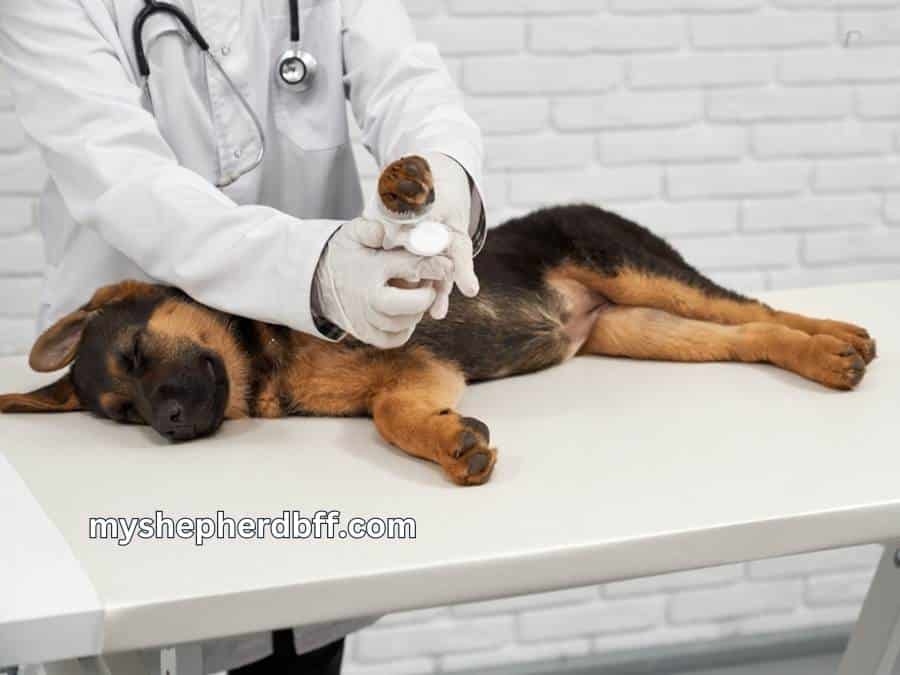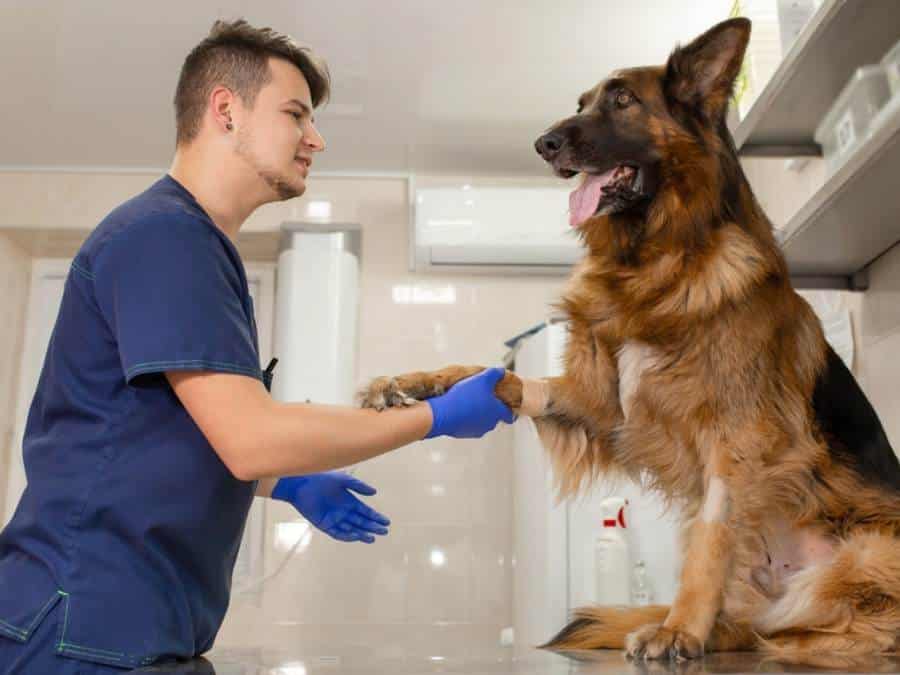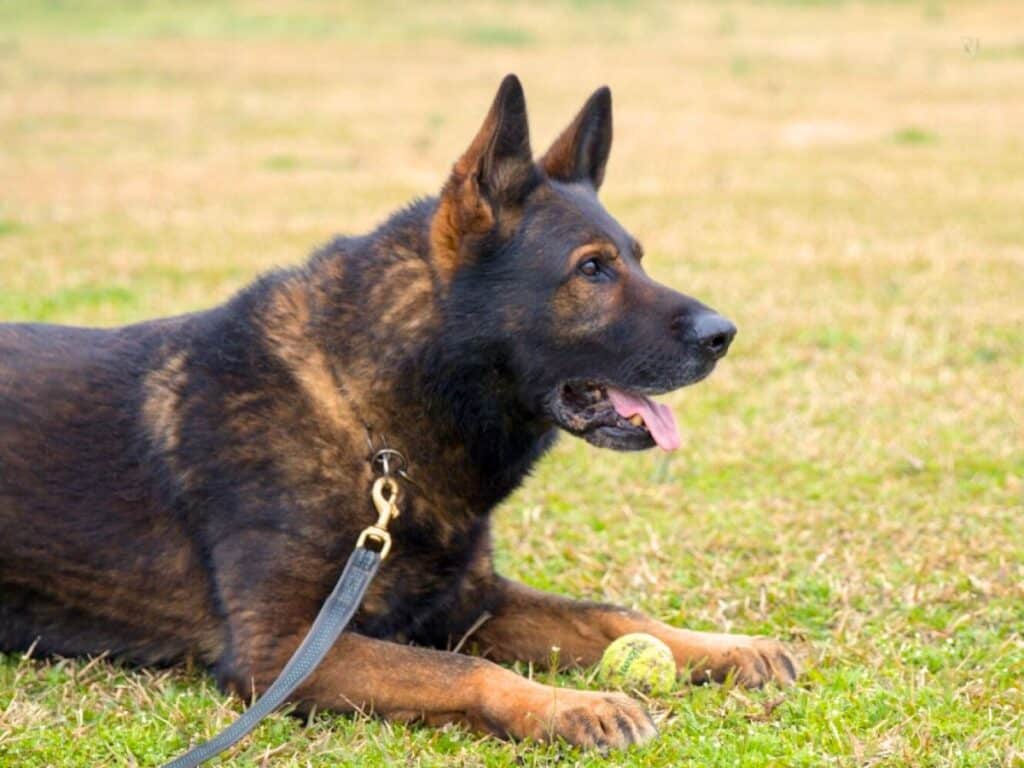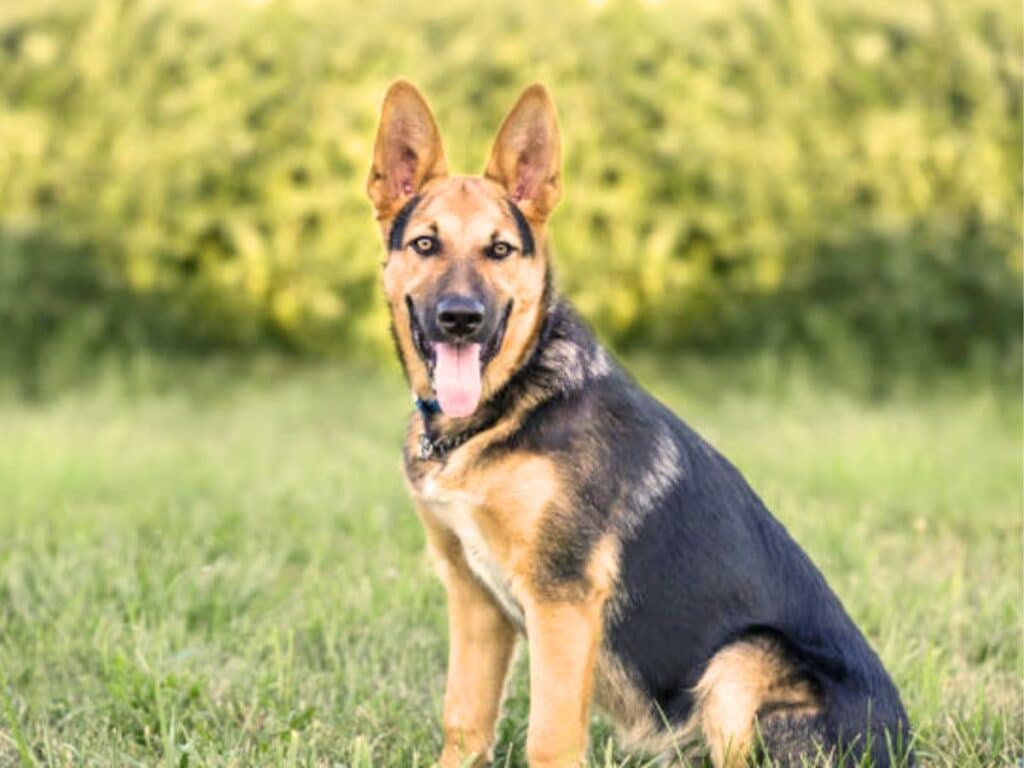Elbow dysplasia in German Shepherds is a common joint disorder that affects the elbow joints, causing pain and lameness in their front legs. If left untreated, it can progress into arthritis, severely impacting their quality of life.
Genetic predisposition plays a significant role in the development of this condition.
In this blog post, through my personal experience of 21 years in raising three GSDs, I aim to shed light on the intricacies of this orthopedic concern, providing insights and practical advice for fellow dog enthusiasts.
Join me on this informative journey as we delve into the nuances of elbow dysplasia in German Shepherds.
What is Elbow Dysplasia?
Elbow dysplasia in dogs is a developmental condition that affects the elbow joint. It is most commonly seen in large and giant breeds, such as Labrador Retrievers, German Shepherds, and Golden Retrievers, although it can occur in smaller breeds as well. (Source)
Elbow dysplasia is actually a collective term for several developmental abnormalities that can affect the elbow joint. These abnormalities may include:
- Fragmented Coronoid Process (FCP): This occurs when a piece of bone within the elbow joint, called the coronoid process, separates from the ulna.
- Osteochondrosis (OCD): OCD is a condition where small pieces of cartilage and underlying bone break loose within the joint. These fragments can cause pain and inflammation.
- Ununited Anconeal Process (UAP): The anconeal process is a bony prominence on one of the bones in the elbow joint called the ulna. In some cases, this process may fail to fuse properly with the rest of the ulna.
These abnormalities can lead to pain, lameness, and arthritis in affected dogs. The exact cause of elbow dysplasia is not fully understood, but it is believed to have a genetic component. Rapid growth and certain dietary factors may also contribute to its development.
Diagnosis is typically based on a combination of clinical signs, physical examination, and diagnostic imaging such as X-rays. Treatment options may include medication for pain and inflammation, weight management, physical therapy, and in some cases, surgical intervention to address the specific abnormalities within the joint.
Click here to learn more about the common health concerns that may affect German Shepherds.
Symptoms of Elbow Dysplasia in German Shepherds

It’s essential for dog owners to be aware of the symptoms associated with this condition so they can seek early intervention and provide their furry friends with the necessary care. Here are some key signs to watch out for:
1. Lameness or limping, especially after exercise
If you notice your pup favoring one leg or exhibiting an abnormal gait, it could be a sign that their elbows are affected. This lameness may worsen over time as the condition progresses.
2. Stiffness and difficulty getting up or lying down
German Shepherds with elbow dysplasia often experience stiffness in their joints, making it challenging for them to get up or lie down comfortably.
You may observe your dog struggling to rise from a resting position or displaying hesitation when attempting to lie down. This stiffness can cause discomfort and limit their range of motion.
3. Swelling and pain around the elbow joints
You might notice your German Shepherd displaying sensitivity when you touch or manipulate their elbows. The presence of swelling can further contribute to discomfort and restricted movement.
4. Reluctance to use affected leg(s)
Dogs suffering from elbow dysplasia may avoid putting weight on those limbs while walking or running, favoring other legs instead.
This behavior is a clear indication that there is an issue with their elbows causing discomfort during weight-bearing activities.
5. Loss of muscle mass in the affected limb(s)
Over time, dogs with elbow dysplasia may experience muscle atrophy in the affected limb(s). This loss of muscle mass is a result of reduced use and limited mobility due to the condition.
If you notice that one of your German Shepherd’s legs appears thinner or less muscular compared to the others, it could be a sign of elbow dysplasia.
6. Decreased range of motion
Elbow dysplasia can lead to a reduced range of motion in the affected joint. Dogs may have difficulty fully extending or flexing the elbow.
7. Swelling and heat
Swelling and warmth around the elbow joint may be present, indicating inflammation. These symptoms can be felt by gently palpating the affected area.
It’s important to note that these symptoms can vary in severity from dog to dog. Some German Shepherds may only display mild signs initially, while others may exhibit more pronounced indications of elbow dysplasia.
Regardless, if you observe any of these symptoms in your furry companion, it is crucial to consult with a veterinarian for an accurate diagnosis and appropriate treatment options.
RELATED:

Causes of German Shepherd Elbow Dysplasia
Elbow dysplasia in German Shepherds can be attributed to several factors. Understanding these causes can help dog owners take preventive measures and provide appropriate care for their furry friends.
1. Genetic factors inherited from parents with the condition
This condition can be passed down from one generation to another, meaning that if a parent has elbow dysplasia, there is a higher likelihood that their offspring will develop it as well.
This genetic predisposition makes it crucial for breeders to carefully select mating pairs and conduct health screenings to minimize the risk.
2. Rapid growth during puppyhood
German Shepherds are known for their rapid growth during puppyhood. While this growth spurt is normal, it can also contribute to the development of elbow dysplasia.
The bones, joints, and cartilage may not grow at an even rate, leading to abnormalities and misalignments in the elbows.
It is important for owners to ensure controlled growth by providing proper nutrition and avoiding excessive weight gain.
If you want to ensure that your German Shepherd pup reaches its full potential, check out our exclusive article on the German Shepherd Growth & Weight Chart.
3. Excessive weight gain or obesity
Maintaining a healthy weight is essential for overall canine health, including joint health. Excessive weight gain or obesity puts additional stress on the joints, including the elbows.
This added pressure can exacerbate existing elbow dysplasia or increase the risk of developing it. Owners should monitor their German Shepherds’ diet and engage them in regular exercise to prevent excessive weight gain.
4. Poor nutrition during critical growth stages
Proper nutrition plays a vital role in ensuring healthy bone and joint development in German Shepherds. Inadequate nutrition during critical growth stages can hinder optimal bone formation and increase the chances of developing elbow dysplasia.
Providing a balanced diet rich in essential nutrients such as calcium, phosphorus, and vitamins is crucial for maintaining healthy joints.
Every German Shepherd puppy is unique, and so are their dietary requirements. Dive into our comprehensive guide on GSD nutrition to understand the factors that influence your pup’s nutritional needs.
5. Overexertion or repetitive stress on the elbows
German Shepherds are energetic and active dogs that love to play, run, and engage in various physical activities. However, overexertion or repetitive stress on the elbows can contribute to the development of elbow dysplasia.
Activities that involve excessive jumping, rough play, or constant impact on the elbows can strain the joint structures and lead to abnormalities over time.
Owners should ensure that their German Shepherds have adequate rest periods and avoid activities that put excessive stress on their elbows.
6. Hormonal factors
Hormonal influences, including those related to the endocrine system, may also play a role in the development of elbow dysplasia. The interaction between genetics and hormonal factors is complex and not fully understood.
Diagnostic Techniques for Elbow Dysplasia in German Shepherds

To accurately diagnose elbow dysplasia in German Shepherds, a thorough examination by a veterinarian is essential. This involves assessing the dog’s medical history and symptoms, as well as conducting various diagnostic tests.
Let’s delve into the different techniques used for diagnosing elbow dysplasia in German Shepherds.
1. Physical examination by a veterinarian
The first step in diagnosing elbow dysplasia is a physical examination performed by a skilled veterinarian. During this examination, the vet will carefully evaluate the dog’s gait, range of motion, and any signs of lameness or discomfort.
They will also palpate the affected joints to check for swelling, pain, or instability.
2. X-rays to assess joint abnormalities
X-rays, also known as radiographs, play a crucial role in diagnosing elbow dysplasia. These images provide valuable insights into the structure and condition of the dog’s joints. (Source)
The vet will take specific X-ray views that allow them to assess the presence of abnormalities such as osteophytes (bone spurs), incongruity between joint components, and signs of arthritis.
3. Arthroscopy for a more detailed evaluation
In some cases, an arthroscopy may be recommended to obtain a more detailed evaluation of the affected joints. Arthroscopy is a minimally invasive procedure that involves inserting a small camera called an arthroscope into the joint through tiny incisions.
This allows the veterinarian to visualize the joint surfaces directly and identify any lesions or cartilage damage that may contribute to elbow dysplasia.
Arthroscopy not only aids in diagnosis but can also serve as a therapeutic tool by allowing certain surgical procedures to be performed simultaneously if necessary.
4. Evaluation of medical history and symptoms
Alongside physical examinations and imaging techniques, evaluating the dog’s medical history and symptoms is crucial for accurate diagnosis. The vet will inquire about any previous injuries or incidents that may have contributed to the development of elbow dysplasia.
They will also ask about specific symptoms such as lameness, stiffness, reluctance to exercise, and difficulty rising or climbing stairs.

Non-Surgical Treatment Options for Elbow Dysplasia
Non-surgical treatment options for elbow dysplasia in dogs focus on managing pain, reducing inflammation, and improving joint function.
While surgery may be necessary in some cases, especially for certain types of elbow dysplasia, non-surgical approaches are often considered as part of the overall management plan.
Here are common non-surgical treatment options:
1. Medications
Nonsteroidal Anti-Inflammatory Drugs (NSAIDs): These drugs, such as carprofen or meloxicam, help reduce pain and inflammation associated with elbow dysplasia. They are commonly prescribed for managing chronic joint conditions.
Pain Medications: Analgesics, such as tramadol, may be prescribed to manage pain in addition to or instead of NSAIDs in some cases.
2. Weight management
Maintaining a healthy body weight is crucial for dogs with elbow dysplasia. Excess weight places additional stress on the joints, exacerbating symptoms. A balanced and controlled diet can help manage weight and reduce joint strain.
3. Physical therapy
Physical therapy, including exercises and stretches prescribed by a veterinary physiotherapist, can help improve joint flexibility and muscle strength.
Hydrotherapy, such as swimming, may also be recommended as it provides low-impact exercise.
4. Joint supplements
Nutritional supplements containing ingredients like glucosamine, chondroitin sulfate, and omega-3 fatty acids may be beneficial in supporting joint health.
These supplements are believed to promote cartilage health and reduce inflammation.
5. Dietary management
Ensuring a balanced and appropriate diet, including nutrients that support joint health, is important. Consult with your veterinarian to determine the most suitable diet for your dog’s specific needs.
6. Activity modification
Limiting high-impact activities, such as running or jumping, can help reduce strain on the affected elbow joint. Controlled exercise that is gentle on the joints, such as leash walks, may be recommended.
7. Anti-arthritic injections
Intra-articular injections of substances like hyaluronic acid or polysulfated glycosaminoglycans may be administered to provide additional lubrication to the joint and potentially reduce inflammation.
It’s important to note that the effectiveness of non-surgical treatments can vary depending on the severity of the condition and the specific abnormalities present in the dog’s elbow joint.
In some cases, a combination of surgical and non-surgical approaches may be employed for optimal management of elbow dysplasia.

Surgical Treatment Options for Elbow Dysplasia
Surgical treatment options for elbow dysplasia in dogs aim to address specific abnormalities within the elbow joint and alleviate pain and lameness.
The choice of surgical procedure depends on the specific type and severity of the elbow dysplasia. Here are some common surgical treatment options:
1. Arthroscopy
Arthroscopy is a minimally invasive surgical technique that involves the use of a small camera (arthroscope) and specialized instruments inserted through small incisions.
This approach is often used to diagnose and treat conditions like fragmented coronoid process (FCP) and osteochondritis dissecans (OCD).
Arthroscopy allows for visualization of the joint and removal of loose bone or cartilage fragments.
2. Fragment excision
In cases where there are fragments of bone or cartilage causing issues within the joint, a surgeon may opt to remove these fragments. This procedure, known as fragment excision, can be performed arthroscopically or through traditional open surgery.
3. Joint debridement
Joint debridement involves removing damaged or diseased tissue within the joint to improve its function and reduce inflammation. This procedure may be performed in conjunction with other surgical techniques.
4. Joint fusion (Arthrodesis)
In severe cases where other surgical options are not viable or have not been successful, joint fusion may be considered.
Arthrodesis involves surgically stabilizing the joint by promoting the fusion of the bones on either side of the joint. While this eliminates movement in the affected joint, it can provide pain relief.
5. Osteotomy
Osteotomy is a surgical procedure that involves cutting and repositioning bones to improve joint alignment. It may be considered in cases where abnormal joint congruence contributes to elbow dysplasia.
6. Total elbow replacement
In some advanced cases of elbow dysplasia, total elbow replacement may be considered. This involves surgically removing the damaged joint and replacing it with an artificial joint.
Total elbow replacement is a complex procedure with potential complications and is typically reserved for cases where other surgical options have been exhausted.
It’s important to note that the choice of surgical treatment depends on the individual dog’s condition, the specific abnormalities present, and the surgeon’s assessment.
After surgery, a rehabilitation plan, including controlled exercise and physical therapy, is often recommended to optimize recovery and improve long-term outcomes.

German Shepherd Elbow Dysplasia Surgery Cost
While there are various treatment options available for this ailment, sometimes surgery becomes necessary to alleviate the symptoms and improve the dog’s quality of life.
However, it’s essential to consider the cost associated with German Shepherd elbow dysplasia surgery before making a decision. Let’s take a closer look at the factors that influence the cost.
Factors affecting the surgery cost
- Type of Surgery: The specific surgical procedure required for treating elbow dysplasia can vary depending on the severity of the condition and individual circumstances. Common surgeries include arthroscopy, osteotomy, or joint replacement. Each procedure has its own associated costs due to differences in complexity and resources required.
- Veterinary Clinic Location: The location of the veterinary clinic plays a significant role in determining the overall cost of surgery. Veterinary services tend to be more expensive in urban areas compared to rural regions due to higher operating costs.
- Veterinarian Experience: The experience and expertise of the veterinarian performing the surgery can impact the cost as well. Highly skilled specialists may charge higher fees for their services.
- Pre-surgical Diagnostic Tests: Before proceeding with surgery, diagnostic tests such as X-rays or MRI scans are often necessary to assess the extent of elbow dysplasia and plan for an appropriate surgical approach. These tests add to the overall cost.
- Postoperative Care: After surgery, your German Shepherd will require postoperative care, including medications, physical therapy sessions, follow-up appointments, and potential complications management if they arise. These additional expenses should be taken into account when considering surgery costs.
Average cost for German Shepherd elbow dysplasia surgery
The cost of German Shepherd elbow dysplasia surgery can vary significantly depending on the factors mentioned above.
On average, you can expect to spend anywhere between $1,500 to $4,000 or more for the surgical procedure.
However, it’s important to note that these figures are approximate and can differ based on individual cases and geographical location.
Additional Expenses to Consider
In addition to the surgery itself, there are other expenses that may arise during the treatment of German Shepherd elbow dysplasia:
- Preoperative Consultations: Before surgery, your dog will likely need consultations with a veterinarian specializing in orthopedics. These consultations may have separate fees.
- Medications: Pain medications and antibiotics prescribed after surgery will incur additional costs.
- Physical Therapy: Rehabilitation exercises and physical therapy sessions are often recommended post-surgery to aid in recovery. These sessions may require ongoing payments.
- Follow-up Visits: Regular follow-up visits are necessary to monitor your dog’s progress and ensure proper healing. Each visit may involve consultation fees.
How To Prevent Elbow Dysplasia in German Shepherds
Preventing elbow dysplasia in German Shepherds involves a combination of responsible breeding practices, appropriate nutrition, controlled exercise, and regular veterinary care.
While genetic factors play a significant role, there are steps that can be taken to reduce the risk of this condition. Here are some preventive measures:
1. Choose responsible breeding
Select reputable breeders who prioritize the health and genetic screening of their breeding dogs. Responsible breeding practices aim to reduce the prevalence of genetic conditions, including elbow dysplasia, within the breed.
2. Genetic testing
Utilize genetic testing for breeding dogs to identify carriers of genetic factors associated with elbow dysplasia. This can help breeders make informed decisions to minimize the risk of passing on these traits to offspring.
3. Balanced nutrition
Provide a well-balanced and appropriate diet for German Shepherd puppies to support healthy growth. Avoid excessive caloric intake and inappropriate calcium and phosphorus ratios, as rapid growth can contribute to orthopedic issues.
4. Controlled exercise
Avoid excessive or high-impact exercise, especially during the puppy growth phase. Allow puppies to develop at a moderate pace to reduce the stress on developing joints. Controlled, low-impact activities like leash walks are preferable.
5. Weight management
Maintain a healthy body weight throughout the dog’s life. Excess weight can contribute to joint stress and exacerbate orthopedic conditions. Consult with a veterinarian to establish an appropriate diet and feeding plan.
6. Regular veterinary check-ups
Schedule regular veterinary check-ups to monitor your dog’s overall health and catch any potential orthopedic issues early. Early detection allows for prompt intervention and management.
7. Joint supplements
Consider incorporating joint supplements into your dog’s diet, especially for large or giant breeds. Glucosamine, chondroitin sulfate, and omega-3 fatty acids are commonly included in joint supplements and may support joint health.
8. Avoid trauma
Minimize the risk of traumatic injury to the elbows by preventing activities that could lead to falls or collisions. Supervise playtime, particularly with other dogs or in unfamiliar environments.
Exercises for Elbow Problems in German Shepherds
When a German Shepherd has elbow problems, it’s crucial to approach exercises with caution to avoid exacerbating the condition.
Exercise should focus on maintaining joint flexibility, promoting muscle strength, and supporting overall joint health. Here are some exercises that can be beneficial for German Shepherds with elbow issues:
1. Stretching exercises
Stretching exercises are beneficial for relieving muscle tension and increasing flexibility in the joints. Here are a few stretching exercises you can try with your German Shepherd:
- Gentle Leg Extensions: Gently extend one leg at a time, holding it in place for a few seconds before releasing. Repeat this exercise on both legs to stretch the muscles around the elbows.
- Front Leg Lifts: Lift your dog’s front leg off the ground, holding it up for a few seconds before lowering it down. This exercise helps stretch the muscles and ligaments surrounding the elbow joint.
2. Low-impact cardiovascular exercises
Low-impact cardiovascular exercises are ideal for maintaining overall fitness without putting excessive strain on the joints. These exercises help keep your German Shepherd active while minimizing stress on their elbows. Some examples include:
- Swimming: Swimming is an excellent low-impact exercise that provides a full-body workout without placing weight-bearing stress on the joints.
- Walking: Regular walks at a moderate pace can help maintain muscle tone and promote healthy circulation without putting too much strain on the elbows.
3. Strength-building exercises
Building strength in the muscles surrounding the elbow joint can provide stability and support, reducing discomfort caused by elbow dysplasia. Here are some strength-building exercises you can incorporate into your German Shepherd’s routine:
- Sit-to-Stand: Encourage your dog to sit down and then stand up repeatedly using their front legs. This exercise helps strengthen the muscles around the elbows.
- Hill Climbing: Find a gentle incline or hill and encourage your dog to walk or run up and down it. This exercise engages the muscles in their legs, including those around the elbows.
4. Controlled movement exercises
Controlled movement exercises focus on improving coordination and balance while minimizing strain on the joints. These exercises help strengthen the supporting muscles and ligaments around the elbow joint. Consider trying these exercises:
- Balance Exercises: Encourage your pup to stand on an unstable surface, such as a balance disc or cushion, to improve proprioception and stability.
- Weave Poles: Set up a series of weave poles for your dog to navigate through at a controlled pace. This exercise helps improve coordination and strengthens the muscles in their legs.
Proper Nutrition for Elbow Issues in Dogs
A well-balanced and nutrient-dense diet can support overall joint health, reduce inflammation, and contribute to the overall well-being of your dog.
Here are some considerations for providing proper nutrition for dogs with elbow issues:
1. Balanced diet
Ensure your dog receives a balanced and complete diet that meets their specific life stage and health requirements. A balanced diet should provide the right proportions of protein, fats, carbohydrates, vitamins, and minerals.
2. Omega-3 fatty acids
Omega-3 fatty acids, found in fish oil, are known for their anti-inflammatory properties. Including sources of omega-3 fatty acids in your dog’s diet can help manage inflammation associated with elbow issues.
Fish oil supplements are available and can be recommended by your veterinarian.
3. Joint supplements
Consider incorporating joint supplements that contain glucosamine and chondroitin sulfate. These compounds are believed to support joint health by promoting the maintenance of cartilage and reducing inflammation.
Consult with your veterinarian to determine the appropriate dosage and form of supplementation.
4. Protein quality
Ensure that your dog receives high-quality protein sources in their diet. Protein is essential for muscle maintenance and repair, which is crucial for supporting the overall structure of the musculoskeletal system.
5. Controlled calcium and phosphorus levels
Large and giant breeds, including those prone to elbow dysplasia, may benefit from diets with controlled levels of calcium and phosphorus. Excessive levels of these minerals can contribute to abnormal bone development.
6. Antioxidants
Antioxidants, such as vitamins C and E, can help neutralize free radicals and reduce oxidative stress in the body. Including fruits and vegetables in your dog’s diet can be a natural source of antioxidants.
7. Hydration
Ensure your dog has access to clean and fresh water at all times. Proper hydration is essential for joint health, as it helps maintain the synovial fluid that lubricates the joints.
Work closely with your veterinarian to tailor your dog’s diet to their specific needs. Your veterinarian can provide guidance on choosing the right commercial dog food or recommend a therapeutic diet if necessary.
Life Expectancy of a GSD with Elbow Dysplasia
The life expectancy of a German Shepherd with elbow dysplasia can vary based on several factors, including the severity of the condition, the effectiveness of management and treatment, and the overall health of the individual dog.
Elbow dysplasia itself is a chronic, progressive condition that affects the joints, and while it can impact a dog’s quality of life, it does not necessarily determine their lifespan.
With proper veterinary care, management strategies, and lifestyle adjustments, many dogs with elbow dysplasia can lead fulfilling lives.
The goal of treatment is often to alleviate pain, manage inflammation, and slow down the progression of arthritis associated with the condition.
Management strategies may include medications, weight management, controlled exercise, physical therapy, and, in some cases, surgical intervention. These measures can help improve the dog’s comfort and mobility.
Dogs with this condition can live into their typical lifespan for the breed if the disease is managed effectively. The average lifespan of a German Shepherd is typically around 9 to 13 years, but individual variations can occur.
Conclusion
In conclusion, elbow dysplasia is a common condition that affects German Shepherds, causing discomfort and limiting their mobility. By understanding the symptoms, causes, and treatment options for elbow dysplasia in German Shepherds, you can take proactive steps to manage the condition and improve your dog’s quality of life. Remember to consult with your veterinarian for an accurate diagnosis and personalized treatment plan.
FAQs
1. Can elbow dysplasia be prevented?
Preventing elbow dysplasia entirely may not be possible since it has a genetic component. However, you can reduce the risk by choosing a reputable breeder who screens their breeding dogs for this condition. Providing proper nutrition during the growth stages of your German Shepherd’s life can help support healthy bone development.
2. How long does recovery take after elbow dysplasia surgery?
The recovery time after surgery will vary depending on the severity of the condition and the specific surgical procedure performed. Generally, it takes several weeks to a few months for dogs to recover fully from elbow dysplasia surgery.
3. Are there any alternative therapies that can help manage elbow dysplasia?
Yes, there are alternative therapies that can complement traditional treatments for elbow dysplasia in German Shepherds. These may include physical therapy, acupuncture, hydrotherapy, or supplements like glucosamine and chondroitin sulfate.
4. Can elbow dysplasia affect both front legs of a German Shepherd?
Yes, elbow dysplasia can affect both front legs of a German Shepherd. It is not uncommon for dogs with this condition to experience bilateral elbow dysplasia, which means both elbows are affected. It is important to address the condition in both limbs to provide optimal care and alleviate any pain or discomfort.
5. Is elbow dysplasia curable?
Elbow dysplasia is not considered curable, but it can be effectively managed through various treatment options. With proper care, including medication, surgery if necessary, and lifestyle modifications, you can significantly improve your German Shepherd’s comfort and mobility.
Also read:




